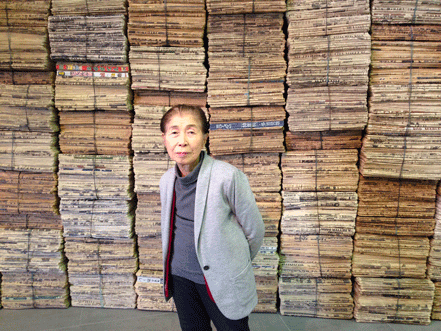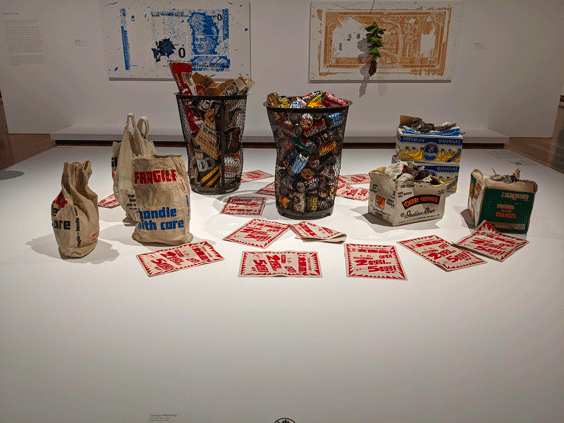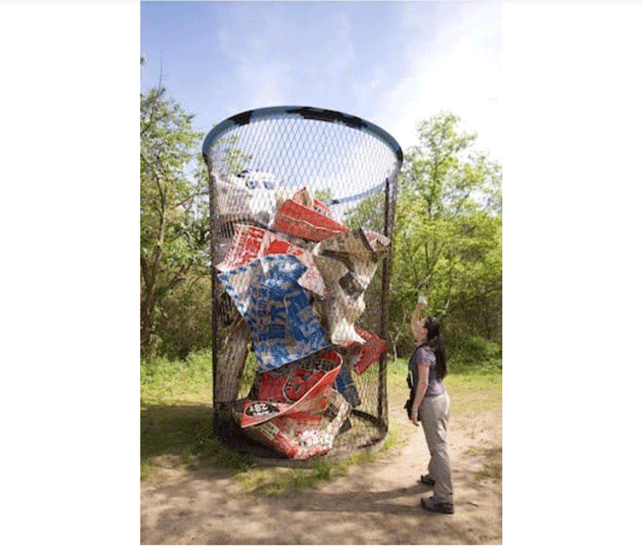Kimiyo Mishima, an artist hailing from Japan, has been practising for seven decades. She is a sculptor whose primary medium is ceramics; although, one could say more accurately, Mishima is an illusionist.

Born during 1932 in Osaka, Mishima began oil painting in school, after encouragement from her teacher. The artist’s early works are representative of her strong interest in collage and the genre of still life, which allowed her to demonstrate her use of printed materials such as newspapers, magazines, pamphlets and advertisements.
Her passion for ceramic sculpture, however, started in the 1970s. She admired the fragility and instability of ceramic works, and how they necessitate great care and caution. Together with her previous experience working with silkscreen on canvas, Mishima found the utilisation of silkscreen on ceramic supports to be quite a natural transition.
Mishima’s newspaper works, often appearing in bundles or exhibited as being crumpled and discarded, are illustrative of how quickly sources of information and entertainment are relegated to the rubbish pile.

In an interview with the 21st Century Museum of Contemporary Art, Mishima spoke of her realisation that these artworks carried meaning in a society obsessed with capitalist consumption and never-ending waves of mass information.
“That’s when it hit me, I was making garbage in an age of garbage,” Mishima states. “Garbage was just so much fun”.
Mishima’s artworks are hyper-illusionistic screen printed and hand-coloured ceramics. This dichotomous element to her work is precisely the characteristic that makes it so poignant. On the one hand, it is so realistic you could almost reach out and touch it, and on the other, it is a sight we see every day — visible debris, evidence of our throwaway society.
By taking such a traditional and historically important medium like ceramics, which dictates fine detail and delicate handling, and bestowing that same sense of time and sensitivity to our daily waste, Mishima provides a metaphorical mirror to our collective problem of wastefulness.
“My work is a record of daily life,” the artist herself affirms. “It embodies modernity."
Conscious of our contemporary habit for over-consuming and the resulting ubiquitous waste that we cannot sustainably process, Mishima’s œuvre aligns with the United Nations Sustainable Development Goals Sustainable Cities and Communities and Responsible Consumption and Production.
Currently on display at the Queensland Art Gallery | Gallery of Modern Art as part of the Asia Pacific Triennial of Contemporary Art (APT), Mishima’s installation features eight art works presented as an inharmonious display of food and drink packaging, advertising flyers and newspaper pages.

Four fruit boxes seemingly made from cardboard (three of which are filled with old newspapers), three paper bags which boldly instruct their fleeting owner to handle them with care as they are fragile, and two rubbish bins (one filled with used cans of soft drink and beer, and the other bursting with even more tattered cardboard boxes) — this myriad pile of what first appears to be nothing but junk and garbage is made entirely from ceramics.

Mishima’s pieces exhibited here date from as early as 1973 and as late as 2019, which sadly informs us that we are still faced with the same troubling issues today. The verisimilitude evident in this selection of works is simply remarkable and indeed, a trick of the eye. Particularly the illusionism of the wastepaper baskets overflowing with squashed aluminium cans and torn cardboard boxes is astonishing.

A plethora of multinational corporations are instantly recognisable, with brands including Coca-Cola, Mello Yello, Mountain Dew, Pepsi, Asahi, Sapporo and Heineken. If the very definition of illusionism is to coax the viewer into complacent acceptance, we too as consumers have been pacified with constant advertising feeding our vices such as greed and gluttony and the needless want of more, more, more.
This specific series of works was inspired by witnessing labourers in Gifu. Mishima observed the workers coming back and throwing away their drinks and rubbish in the baskets, so she duplicated it. Sometimes the work reaches several metres in height, becoming public art and thereby further highlighting over-consumption as a universal public problem.
Certainly, Mishima hopes to inspire us with her hyper-realistic art works, urging spectators to heed her message and act; to be better and more responsible when it comes to our waste.

Together, let’s think more consciously when we dispose of our waste. Can we re-use or re-fill, and what can we recycle? Fight single-use plastic by taking a reusable coffee cup with you, and make sure you carry a reusable water bottle everywhere you go.
